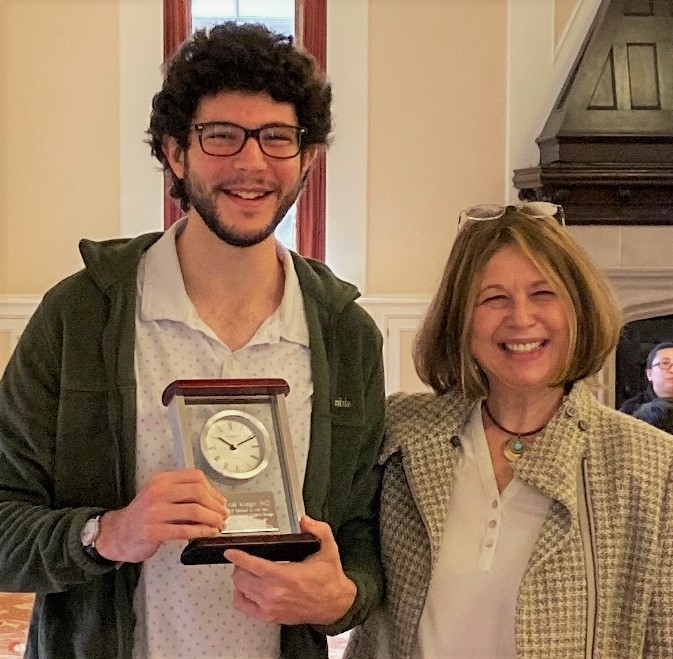 |
 |
 |
| back | |||||
 |
 |
 |
|||
James Krieger received the DCSB Best Postdoctoral Associate Award of the Year 2019. He was nominated by his mentor, Dr. Ivet Bahar. James is the one of three first authors in a seminal paper on the signature dynamics of proteins, Shared signature dynamics tempered by local fluctuations enables fold adaptability and specificity, published in Mol Biol Evol. Please click here for more information.
Dr. Luca Ponzoni received the "Best Postdoc Award at the Department of Computational & Systems Biology — Year 2018" at the Annual Departmental Retreat in recognition of his outstanding work on the evaluation of the functional impact of missense variants (see Ponzoni & Bahar, Proc Natl Acad Sci USA 2018)
She (John) Zhang has been selected to represent Pitt's graduate students during the 2018 Pitt Day in Harrisburg, PA. She will present a poster (pictured below) to state lawmakers. She (John) Zhang has received the Best DCSB Student Award for 2017, for his structure-based study of chromosomal dynamics using elastic network models. Below is a photo during his speech, after receiving the award, at the annual CSB Retreat Banquet. Cihan received the Best DCSB Student Award for 2016 for his work on developing multi-scale models and simulations for dopaminergic signaling. He aims at understanding the effect of spatial complexity and heterogeneity in the efficiency of dopamine (DA) reuptake. Below is a snapshot from his simulations, displaying the release of DA (red dots) from active zones on DA neurons (green). John received the best poster award in the DCSB retreat in June 2016 for his work on the ENM analysis of chromosome contact maps determined by Hi-C experiment. Hongchun received the Best DCSB Postdoc Award for 2016 for developing the iGNM database and oGNM server, published in Nucleic Acids Research. The upgraded iGNM 2.0 database provides a user-friendly interface for retrieving information on the dynamics of 95% of Protein Data Bank (PDB) structures as well as their biological assemblies. It helps assess which structural elements undergo large correlated fluctuations, and enable conformational changes that may be relevant to function.
Congratulations to Lidio Meireles, Ying Liu, and Lin Liu on their successful defenses!
Ahmet Bakan's recent PNAS paper on drug binding mechanisms vs. intrinsic changes in shape(PDF). See also his paper: "In vivo chemical screen in zebrafish reveals a novel modulator of FGF signaling"
Dr. Lee Wei Yang, a former graduate student has recieved the Stephen L. Phillips Award
(click to see full image) Former student Lee-Wei Yang published article in Pitt magazine " Investigations: Explorations and revalations taking place in the medical school"
|
|
We focused on the dopamine-binding and –unbinding free energies of human dopamine transporter (hDAT) using advanced molecular dynamics methods and characterized the conformational spectrum of hDAT. Transition of apo hDAT from outward-facing to inward-facing state, and vice versa was studied, permitting us to generate for the first time a first estimate of the energy landscape of hDAT. "Significance of p53 dynamics in regulating apoptosis in response to ionizing radiation, and polypharmacological strategies" Liu B, Bhatt D, Oltvai ZN, Greenberger JS, Bahar ISci Rep (2014) 4:6245. PMID: 25175563 Controlling ionizing radiation (IR)-induced cell death mitigates radiation damage. Examining tumor suppressor protein p53 network dynamics in response to IR damage found that the strength of p53 transcriptional activity and its coupling (or timing with respect) to mitochondrial pore opening are major determinants of cell fate. "Mechanisms of CFTR functional variants that impair regulated bicarbonate permeation and increase risk for pancreatitis but not for cystic fibrosis" LaRusch J et al.PLoS Genetics (2014) 10:e1004376. PMID: 2503378 Bahar research featured in winter 2014/2015 issue of Pitt Med. "Coupled Global and Local Changes Direct Substrate Translocation by Neurotransmitter-Sodium Symporter Ortholog LeuT" Cheng MH, Bahar I (2013) Biophys J. 105:630-639. PMID: 23931311 This is a first attempt to complete the molecular description of all steps involved in LeuT transport cycle. Notably, the secondary substrate-binding site S2, the functional relevance of which has been debated, appears to stably bind an alanine only when the transporter assumes an intermediate conformer close to inward-facing state.
|
|||







.jpg)












 "Protonation of Glutamate-208 Induces the Release of Agmatine in an Outward-Facing Conformation of Arginine/Agmatine Antiporter."
"Protonation of Glutamate-208 Induces the Release of Agmatine in an Outward-Facing Conformation of Arginine/Agmatine Antiporter." "Molecular simulations elucidate the substrate translocation pathway in a glutamate transporter."
"Molecular simulations elucidate the substrate translocation pathway in a glutamate transporter."